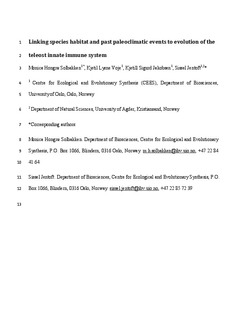| dc.contributor.author | Solbakken, Monica Hongrø | |
| dc.contributor.author | Voje, Kjetil L. | |
| dc.contributor.author | Jakobsen, Kjetill Sigurd | |
| dc.contributor.author | Jentoft, Sissel | |
| dc.date.accessioned | 2017-06-08T10:58:00Z | |
| dc.date.available | 2017-06-08T10:58:00Z | |
| dc.date.created | 2017-04-27T10:30:10Z | |
| dc.date.issued | 2017 | |
| dc.identifier.citation | Proceedings of the Royal Society of London. Biological Sciences. 2017, 284 1-9. | nb_NO |
| dc.identifier.issn | 0962-8452 | |
| dc.identifier.uri | http://hdl.handle.net/11250/2445423 | |
| dc.description.abstract | Host-intrinsic factors as well as environmental changes are known to be strong evolutionary drivers defining the genetic foundation of immunity. Using a novel set of teleost genomes and a time-calibrated phylogeny, we here investigate the family of Toll-like receptor (TLR) genes and address the underlying evolutionary processes shaping the diversity of the first-line defence. Our findings reveal remarkable flexibility within the evolutionary design of teleost innate immunity characterized by prominent TLR gene losses and expansions. In the order of Gadiformes, expansions correlate with the loss of major histocompatibility complex class II (MHCII) and diversifying selection analyses support that this has fostered new immunological innovations in TLRs within this lineage. In teleosts overall, TLRs expansions correlate with species latitudinal distributions and maximum depth. By contrast, lineage-specific gene losses overlap with well-described changes in palaeoclimate (global ocean anoxia) and past Atlantic Ocean geography. In conclusion, we suggest that the evolvability of the teleost immune system has most likely played a prominent role in the survival and successful radiation of this lineage. | |
| dc.language.iso | eng | nb_NO |
| dc.title | Linking species habitat and past palaeoclimatic events to evolution of the teleost innate immune system | nb_NO |
| dc.type | Journal article | nb_NO |
| dc.type | Peer reviewed | nb_NO |
| dc.description.version | acceptedVersion | |
| dc.description.version | publishedVersion | |
| dc.source.pagenumber | 1-9 | nb_NO |
| dc.source.volume | 284 | nb_NO |
| dc.source.journal | Proceedings of the Royal Society of London. Biological Sciences | nb_NO |
| dc.identifier.doi | 10.1098/rspb.2016.2810 | |
| dc.identifier.cristin | 1466876 | |
| dc.relation.project | Norges forskningsråd: 179569 | nb_NO |
| dc.relation.project | Norges forskningsråd: 222378 | nb_NO |
| dc.description.localcode | Nivå2 | |
| cristin.unitcode | 201,15,2,0 | |
| cristin.unitname | Institutt for naturvitenskapelige fag | |
| cristin.ispublished | true | |
| cristin.fulltext | postprint | |
| cristin.fulltext | original | |
| cristin.qualitycode | 2 | |

